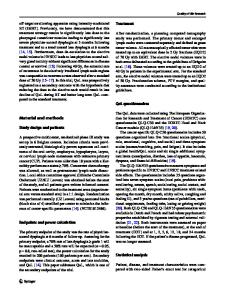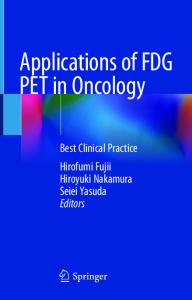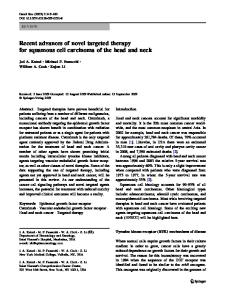Potential of [ 18 F]-Fluoromisonidazole positron-emission tomography for radiotherapy planning in head and neck squamous
- PDF / 417,237 Bytes
- 5 Pages / 595.276 x 790.866 pts Page_size
- 11 Downloads / 312 Views
ues de Figueiredo1, 2 · T. Merlin2 · H. de Clermont-Gallerande3 · M. Hatt4 · D. Vimont5 · P. Fernandez2, 3, 5 · F. Lamare2, 3 1 Department of Radiotherapy, Institut Bergonié, Bordeaux Cedex 2 INCIA UMR-CNRS, Bordeaux 3 Department of Nuclear Medicine, Hospital Pellegrin, CHRU Bordeaux 4 LaTIM INSERM U1101, Brest 5 University Bordeaux 2, Bordeaux
Potential of [18F]-Fluoromisonidazole positron-emission tomography for radiotherapy planning in head and neck squamous cell carcinomas Despite radiation therapy with concurrent chemotherapy or treatment with targeted agents, patients with locoregionally advanced head and neck squamous cell carcinoma (HNSCC) have a poor prognosis. One explanation for this could be the presence of tumour hypoxia, which is known to increase radioresistance. Previous series have correlated poor survival with the presence of hypoxia [12] and in vitro experiments have shown that in order to elicit the same cytotoxic effects as observed in normoxic cells, radiation doses to hypoxic cells must be multiplied by a factor of three [14]. Positron-emission tomography (PET) with [18F]-fluoromisonidazole (FMISO) allows a noninvasive assessment of hypoxia with spatial cartography, which allows an escalation of radiotherapy dose to hypoxic volumes to be considered. The prognostic value of hypoxic tracer imaging has already been demonstrated [17] and a recent publication showed a high reproducibility of tumour hypoxia as evaluated by two FMISO-PET scans acquired within a 48-hour interval, which is a necessary requirement for dose escalation in radiotherapy [13]. However, due to the lipophilicity of FMISO and its slow clearance from normoxic tissues, FMISO-PET images have a low contrast and their use in radio-
therapy planning is complicated. Few data are available on this subject; one study showed recently that improved contrast was obtained with delayed acquisitions at 4 h after FMISO injection [1]. The aims of this study were to confirm that delayed acquisitions are better for FMISO imaging in HNSCC and to study different methods of volume segmentation for radiotherapy. For this purpose, patients with HNSCC underwent FMISO-PET/CT with several acquisitions at 2, 3 and 4 h after injection of the tracer. Different automatic methods for segmentation of PET volumes were then tested.
(n=7), T4 (n=3), N2b (n=2), N2c (n=12) and N3 (n=1). Prior to radiotherapy, all patients underwent FMISO-PET/CT. No surgery and no chemotherapy were performed before PET/CT. FMISO-PET/ CT data were reviewed retrospectively to study the contrast of FMISO images and to assess different automatic segmentation methods. This study was approved by the institutional review board and the French Health Authority. All patients gave their informed consent.
Patients and methods
Image acquisition was performed in the three-dimensional (3D) mode of a PET/ CT integrated system (Discovery RX, GE Medical Systems, Milwaukee, WI, USA). Patients were injected intravenously with 3.7 MBq/kg of [18F]-FMISO. At 2, 3 and 4 h after injection, 10-min static
Data Loading...











